Analyzing the Link Between HR Practices and Organizational Performance
VerifiedAdded on 2023/01/18
|12
|2724
|25
Essay
AI Summary
This essay delves into the critical relationship between Human Resource Management (HRM) and organizational performance. It begins by establishing the significance of HRM in gaining a competitive edge, contrasting this with the increasing reliance on technology. The essay then explores the theoretical concepts that link organizational performance and HRM routines, discussing frameworks such as Resource-Based View (RBV), contingency theory, and the AMO (Ability, Motivation, Opportunity) theory. The AMO theory is highlighted for its emphasis on influencing employee capabilities, motivations, and opportunities to participate. The essay further provides empirical evidence of the positive impact of HR practices, including studies on high-performance work systems and healthcare facilities. Finally, the essay examines the application of the AMO theory in HR-performance, emphasizing how HRM practices can influence individual abilities, motivations, and opportunities within an organization. The conclusion reiterates the importance of understanding the link between HR and organizational performance while acknowledging the limitations in proving a definitive connection.
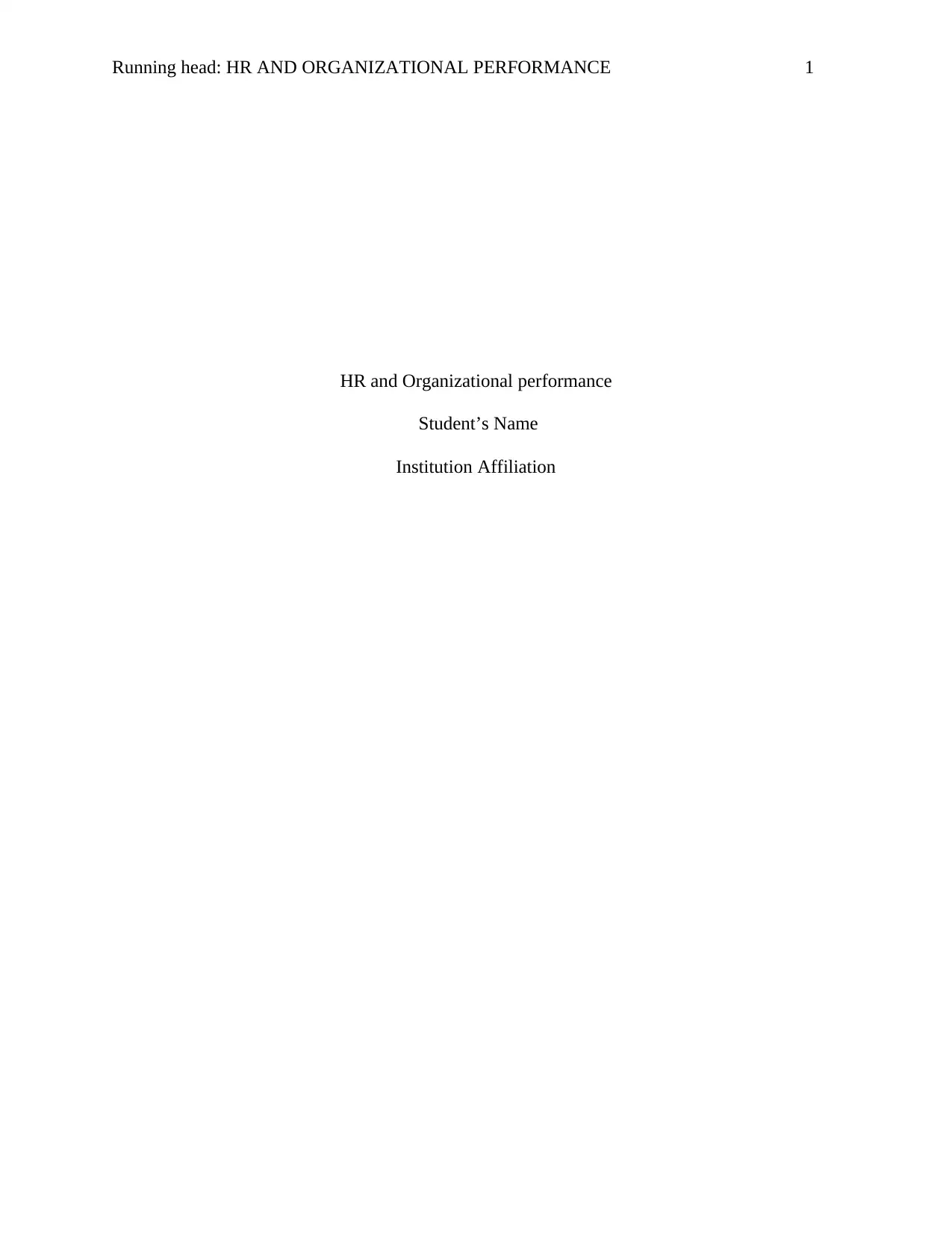
Running head: HR AND ORGANIZATIONAL PERFORMANCE 1
HR and Organizational performance
Student’s Name
Institution Affiliation
HR and Organizational performance
Student’s Name
Institution Affiliation
Paraphrase This Document
Need a fresh take? Get an instant paraphrase of this document with our AI Paraphraser
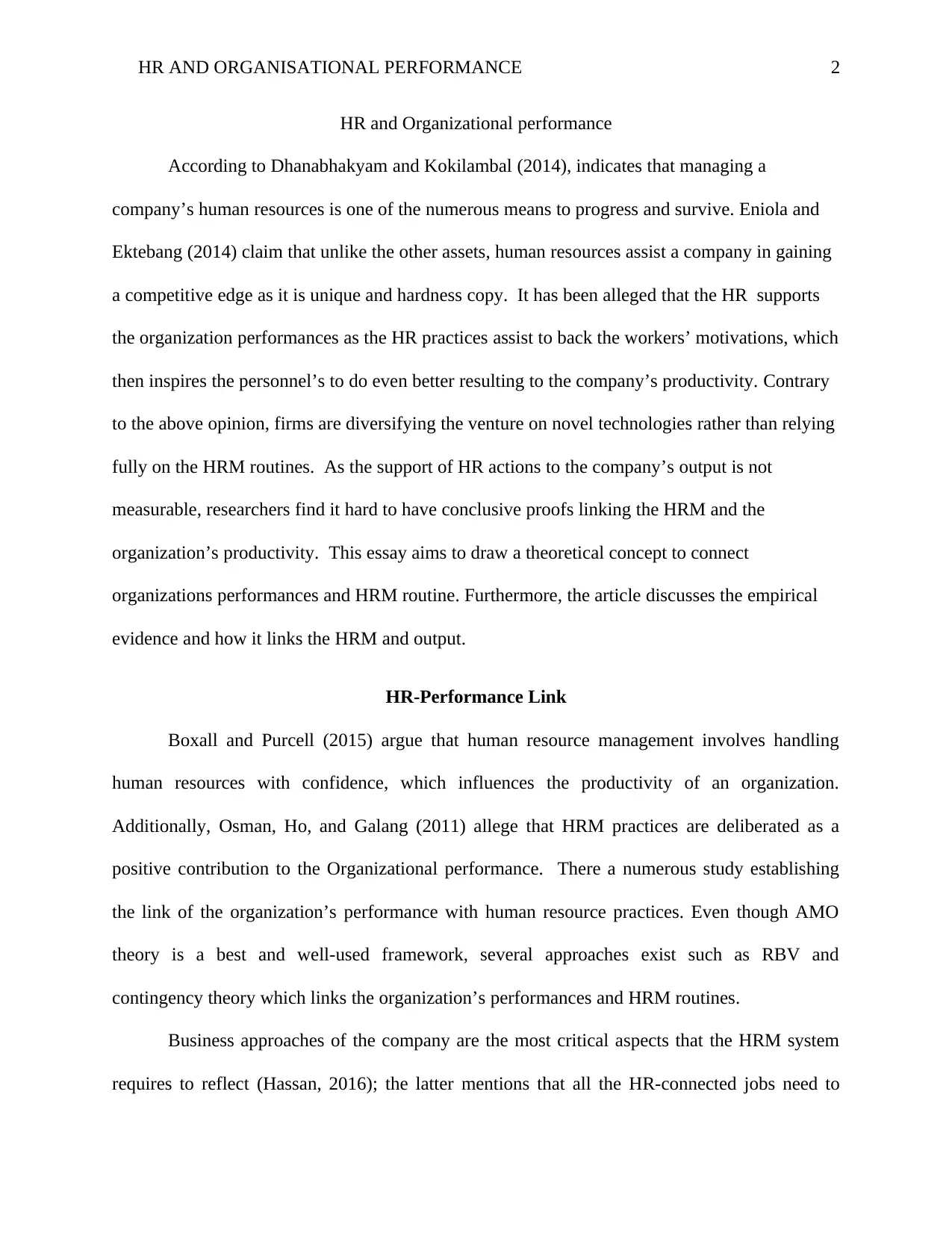
HR AND ORGANISATIONAL PERFORMANCE 2
HR and Organizational performance
According to Dhanabhakyam and Kokilambal (2014), indicates that managing a
company’s human resources is one of the numerous means to progress and survive. Eniola and
Ektebang (2014) claim that unlike the other assets, human resources assist a company in gaining
a competitive edge as it is unique and hardness copy. It has been alleged that the HR supports
the organization performances as the HR practices assist to back the workers’ motivations, which
then inspires the personnel’s to do even better resulting to the company’s productivity. Contrary
to the above opinion, firms are diversifying the venture on novel technologies rather than relying
fully on the HRM routines. As the support of HR actions to the company’s output is not
measurable, researchers find it hard to have conclusive proofs linking the HRM and the
organization’s productivity. This essay aims to draw a theoretical concept to connect
organizations performances and HRM routine. Furthermore, the article discusses the empirical
evidence and how it links the HRM and output.
HR-Performance Link
Boxall and Purcell (2015) argue that human resource management involves handling
human resources with confidence, which influences the productivity of an organization.
Additionally, Osman, Ho, and Galang (2011) allege that HRM practices are deliberated as a
positive contribution to the Organizational performance. There a numerous study establishing
the link of the organization’s performance with human resource practices. Even though AMO
theory is a best and well-used framework, several approaches exist such as RBV and
contingency theory which links the organization’s performances and HRM routines.
Business approaches of the company are the most critical aspects that the HRM system
requires to reflect (Hassan, 2016); the latter mentions that all the HR-connected jobs need to
HR and Organizational performance
According to Dhanabhakyam and Kokilambal (2014), indicates that managing a
company’s human resources is one of the numerous means to progress and survive. Eniola and
Ektebang (2014) claim that unlike the other assets, human resources assist a company in gaining
a competitive edge as it is unique and hardness copy. It has been alleged that the HR supports
the organization performances as the HR practices assist to back the workers’ motivations, which
then inspires the personnel’s to do even better resulting to the company’s productivity. Contrary
to the above opinion, firms are diversifying the venture on novel technologies rather than relying
fully on the HRM routines. As the support of HR actions to the company’s output is not
measurable, researchers find it hard to have conclusive proofs linking the HRM and the
organization’s productivity. This essay aims to draw a theoretical concept to connect
organizations performances and HRM routine. Furthermore, the article discusses the empirical
evidence and how it links the HRM and output.
HR-Performance Link
Boxall and Purcell (2015) argue that human resource management involves handling
human resources with confidence, which influences the productivity of an organization.
Additionally, Osman, Ho, and Galang (2011) allege that HRM practices are deliberated as a
positive contribution to the Organizational performance. There a numerous study establishing
the link of the organization’s performance with human resource practices. Even though AMO
theory is a best and well-used framework, several approaches exist such as RBV and
contingency theory which links the organization’s performances and HRM routines.
Business approaches of the company are the most critical aspects that the HRM system
requires to reflect (Hassan, 2016); the latter mentions that all the HR-connected jobs need to
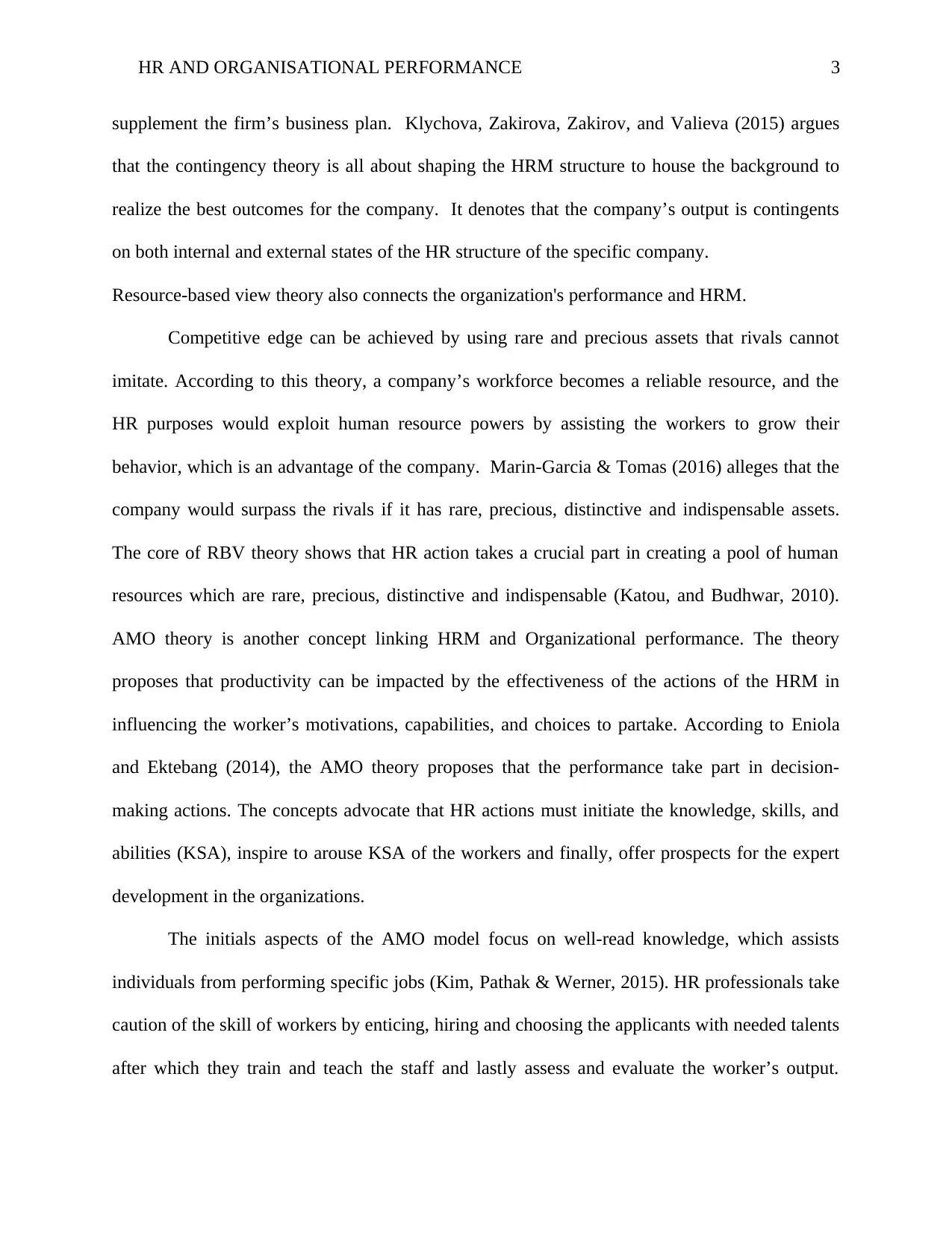
HR AND ORGANISATIONAL PERFORMANCE 3
supplement the firm’s business plan. Klychova, Zakirova, Zakirov, and Valieva (2015) argues
that the contingency theory is all about shaping the HRM structure to house the background to
realize the best outcomes for the company. It denotes that the company’s output is contingents
on both internal and external states of the HR structure of the specific company.
Resource-based view theory also connects the organization's performance and HRM.
Competitive edge can be achieved by using rare and precious assets that rivals cannot
imitate. According to this theory, a company’s workforce becomes a reliable resource, and the
HR purposes would exploit human resource powers by assisting the workers to grow their
behavior, which is an advantage of the company. Marin-Garcia & Tomas (2016) alleges that the
company would surpass the rivals if it has rare, precious, distinctive and indispensable assets.
The core of RBV theory shows that HR action takes a crucial part in creating a pool of human
resources which are rare, precious, distinctive and indispensable (Katou, and Budhwar, 2010).
AMO theory is another concept linking HRM and Organizational performance. The theory
proposes that productivity can be impacted by the effectiveness of the actions of the HRM in
influencing the worker’s motivations, capabilities, and choices to partake. According to Eniola
and Ektebang (2014), the AMO theory proposes that the performance take part in decision-
making actions. The concepts advocate that HR actions must initiate the knowledge, skills, and
abilities (KSA), inspire to arouse KSA of the workers and finally, offer prospects for the expert
development in the organizations.
The initials aspects of the AMO model focus on well-read knowledge, which assists
individuals from performing specific jobs (Kim, Pathak & Werner, 2015). HR professionals take
caution of the skill of workers by enticing, hiring and choosing the applicants with needed talents
after which they train and teach the staff and lastly assess and evaluate the worker’s output.
supplement the firm’s business plan. Klychova, Zakirova, Zakirov, and Valieva (2015) argues
that the contingency theory is all about shaping the HRM structure to house the background to
realize the best outcomes for the company. It denotes that the company’s output is contingents
on both internal and external states of the HR structure of the specific company.
Resource-based view theory also connects the organization's performance and HRM.
Competitive edge can be achieved by using rare and precious assets that rivals cannot
imitate. According to this theory, a company’s workforce becomes a reliable resource, and the
HR purposes would exploit human resource powers by assisting the workers to grow their
behavior, which is an advantage of the company. Marin-Garcia & Tomas (2016) alleges that the
company would surpass the rivals if it has rare, precious, distinctive and indispensable assets.
The core of RBV theory shows that HR action takes a crucial part in creating a pool of human
resources which are rare, precious, distinctive and indispensable (Katou, and Budhwar, 2010).
AMO theory is another concept linking HRM and Organizational performance. The theory
proposes that productivity can be impacted by the effectiveness of the actions of the HRM in
influencing the worker’s motivations, capabilities, and choices to partake. According to Eniola
and Ektebang (2014), the AMO theory proposes that the performance take part in decision-
making actions. The concepts advocate that HR actions must initiate the knowledge, skills, and
abilities (KSA), inspire to arouse KSA of the workers and finally, offer prospects for the expert
development in the organizations.
The initials aspects of the AMO model focus on well-read knowledge, which assists
individuals from performing specific jobs (Kim, Pathak & Werner, 2015). HR professionals take
caution of the skill of workers by enticing, hiring and choosing the applicants with needed talents
after which they train and teach the staff and lastly assess and evaluate the worker’s output.
⊘ This is a preview!⊘
Do you want full access?
Subscribe today to unlock all pages.

Trusted by 1+ million students worldwide
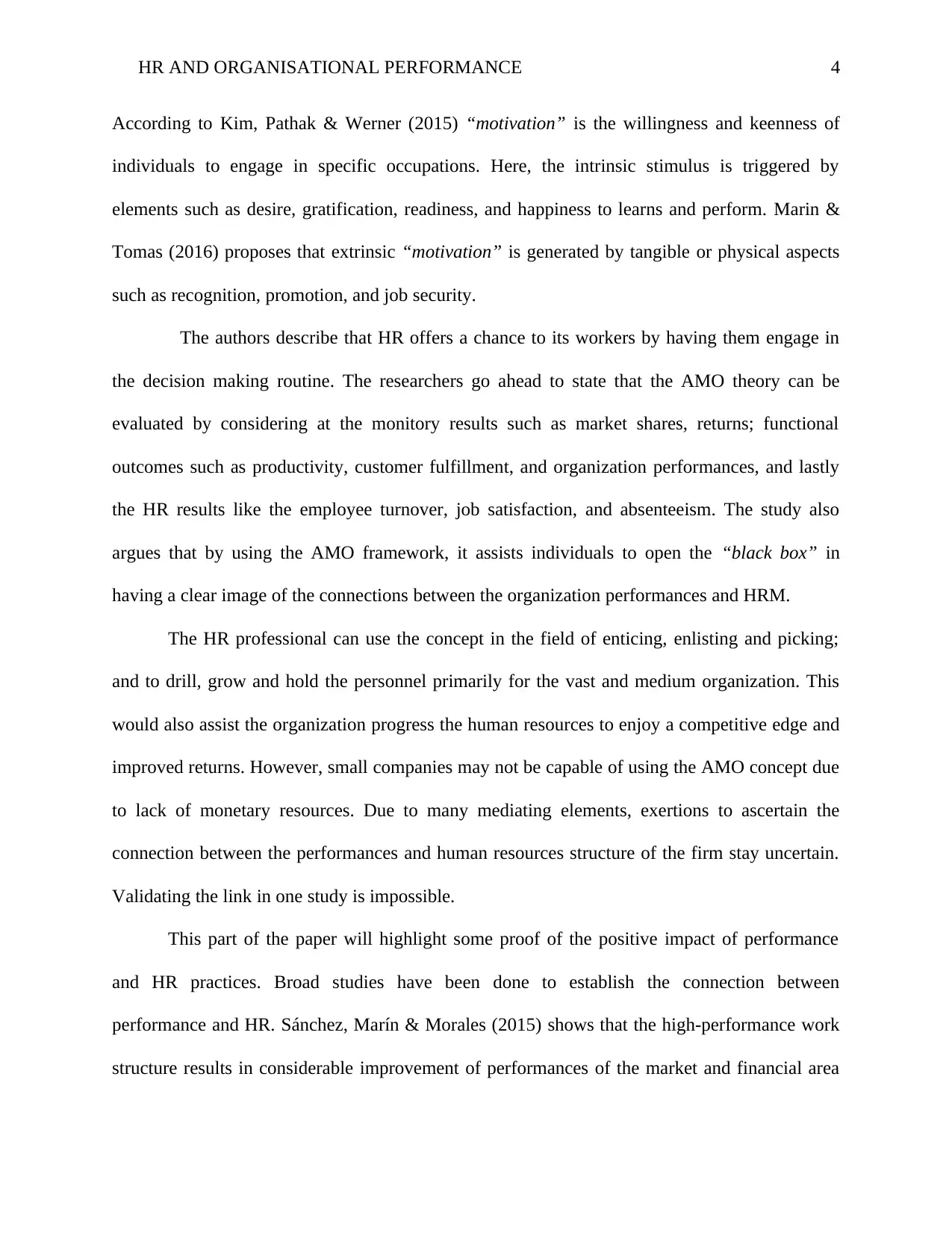
HR AND ORGANISATIONAL PERFORMANCE 4
According to Kim, Pathak & Werner (2015) “motivation” is the willingness and keenness of
individuals to engage in specific occupations. Here, the intrinsic stimulus is triggered by
elements such as desire, gratification, readiness, and happiness to learns and perform. Marin &
Tomas (2016) proposes that extrinsic “motivation” is generated by tangible or physical aspects
such as recognition, promotion, and job security.
The authors describe that HR offers a chance to its workers by having them engage in
the decision making routine. The researchers go ahead to state that the AMO theory can be
evaluated by considering at the monitory results such as market shares, returns; functional
outcomes such as productivity, customer fulfillment, and organization performances, and lastly
the HR results like the employee turnover, job satisfaction, and absenteeism. The study also
argues that by using the AMO framework, it assists individuals to open the “black box” in
having a clear image of the connections between the organization performances and HRM.
The HR professional can use the concept in the field of enticing, enlisting and picking;
and to drill, grow and hold the personnel primarily for the vast and medium organization. This
would also assist the organization progress the human resources to enjoy a competitive edge and
improved returns. However, small companies may not be capable of using the AMO concept due
to lack of monetary resources. Due to many mediating elements, exertions to ascertain the
connection between the performances and human resources structure of the firm stay uncertain.
Validating the link in one study is impossible.
This part of the paper will highlight some proof of the positive impact of performance
and HR practices. Broad studies have been done to establish the connection between
performance and HR. Sánchez, Marín & Morales (2015) shows that the high-performance work
structure results in considerable improvement of performances of the market and financial area
According to Kim, Pathak & Werner (2015) “motivation” is the willingness and keenness of
individuals to engage in specific occupations. Here, the intrinsic stimulus is triggered by
elements such as desire, gratification, readiness, and happiness to learns and perform. Marin &
Tomas (2016) proposes that extrinsic “motivation” is generated by tangible or physical aspects
such as recognition, promotion, and job security.
The authors describe that HR offers a chance to its workers by having them engage in
the decision making routine. The researchers go ahead to state that the AMO theory can be
evaluated by considering at the monitory results such as market shares, returns; functional
outcomes such as productivity, customer fulfillment, and organization performances, and lastly
the HR results like the employee turnover, job satisfaction, and absenteeism. The study also
argues that by using the AMO framework, it assists individuals to open the “black box” in
having a clear image of the connections between the organization performances and HRM.
The HR professional can use the concept in the field of enticing, enlisting and picking;
and to drill, grow and hold the personnel primarily for the vast and medium organization. This
would also assist the organization progress the human resources to enjoy a competitive edge and
improved returns. However, small companies may not be capable of using the AMO concept due
to lack of monetary resources. Due to many mediating elements, exertions to ascertain the
connection between the performances and human resources structure of the firm stay uncertain.
Validating the link in one study is impossible.
This part of the paper will highlight some proof of the positive impact of performance
and HR practices. Broad studies have been done to establish the connection between
performance and HR. Sánchez, Marín & Morales (2015) shows that the high-performance work
structure results in considerable improvement of performances of the market and financial area
Paraphrase This Document
Need a fresh take? Get an instant paraphrase of this document with our AI Paraphraser
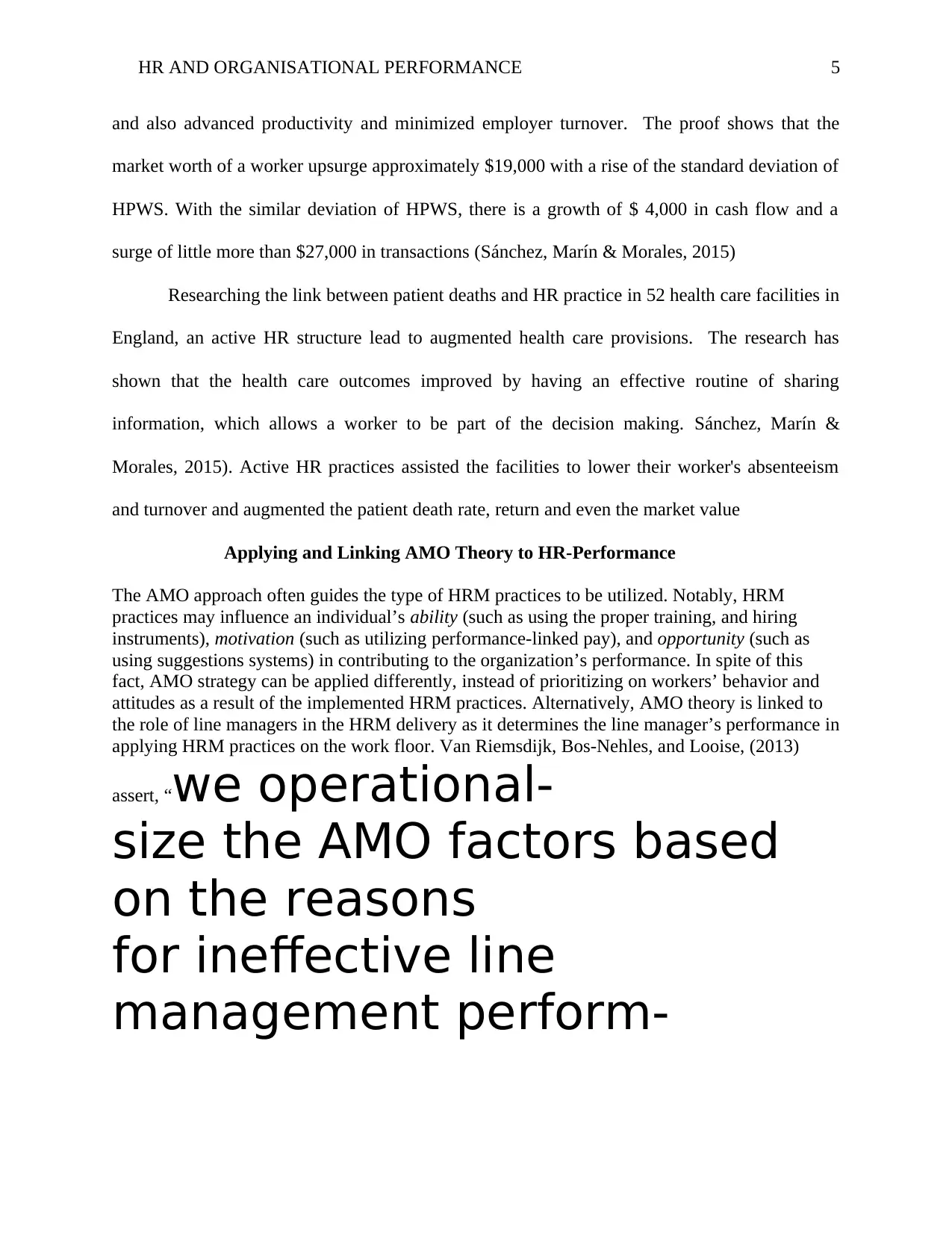
HR AND ORGANISATIONAL PERFORMANCE 5
and also advanced productivity and minimized employer turnover. The proof shows that the
market worth of a worker upsurge approximately $19,000 with a rise of the standard deviation of
HPWS. With the similar deviation of HPWS, there is a growth of $ 4,000 in cash flow and a
surge of little more than $27,000 in transactions (Sánchez, Marín & Morales, 2015)
Researching the link between patient deaths and HR practice in 52 health care facilities in
England, an active HR structure lead to augmented health care provisions. The research has
shown that the health care outcomes improved by having an effective routine of sharing
information, which allows a worker to be part of the decision making. Sánchez, Marín &
Morales, 2015). Active HR practices assisted the facilities to lower their worker's absenteeism
and turnover and augmented the patient death rate, return and even the market value
Applying and Linking AMO Theory to HR-Performance
The AMO approach often guides the type of HRM practices to be utilized. Notably, HRM
practices may influence an individual’s ability (such as using the proper training, and hiring
instruments), motivation (such as utilizing performance-linked pay), and opportunity (such as
using suggestions systems) in contributing to the organization’s performance. In spite of this
fact, AMO strategy can be applied differently, instead of prioritizing on workers’ behavior and
attitudes as a result of the implemented HRM practices. Alternatively, AMO theory is linked to
the role of line managers in the HRM delivery as it determines the line manager’s performance in
applying HRM practices on the work floor. Van Riemsdijk, Bos-Nehles, and Looise, (2013)
assert, “we operational-
size the AMO factors based
on the reasons
for ineffective line
management perform-
and also advanced productivity and minimized employer turnover. The proof shows that the
market worth of a worker upsurge approximately $19,000 with a rise of the standard deviation of
HPWS. With the similar deviation of HPWS, there is a growth of $ 4,000 in cash flow and a
surge of little more than $27,000 in transactions (Sánchez, Marín & Morales, 2015)
Researching the link between patient deaths and HR practice in 52 health care facilities in
England, an active HR structure lead to augmented health care provisions. The research has
shown that the health care outcomes improved by having an effective routine of sharing
information, which allows a worker to be part of the decision making. Sánchez, Marín &
Morales, 2015). Active HR practices assisted the facilities to lower their worker's absenteeism
and turnover and augmented the patient death rate, return and even the market value
Applying and Linking AMO Theory to HR-Performance
The AMO approach often guides the type of HRM practices to be utilized. Notably, HRM
practices may influence an individual’s ability (such as using the proper training, and hiring
instruments), motivation (such as utilizing performance-linked pay), and opportunity (such as
using suggestions systems) in contributing to the organization’s performance. In spite of this
fact, AMO strategy can be applied differently, instead of prioritizing on workers’ behavior and
attitudes as a result of the implemented HRM practices. Alternatively, AMO theory is linked to
the role of line managers in the HRM delivery as it determines the line manager’s performance in
applying HRM practices on the work floor. Van Riemsdijk, Bos-Nehles, and Looise, (2013)
assert, “we operational-
size the AMO factors based
on the reasons
for ineffective line
management perform-
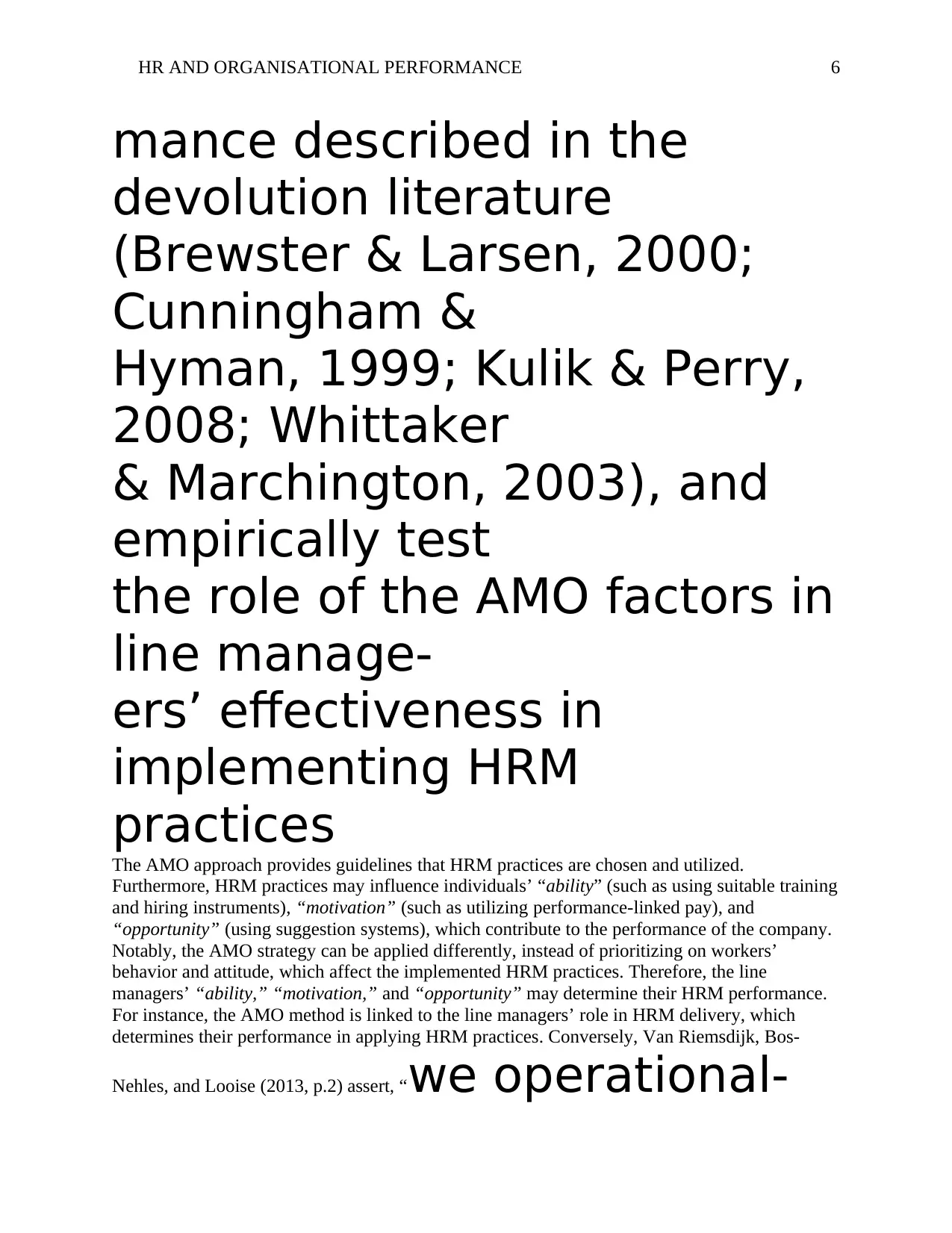
HR AND ORGANISATIONAL PERFORMANCE 6
mance described in the
devolution literature
(Brewster & Larsen, 2000;
Cunningham &
Hyman, 1999; Kulik & Perry,
2008; Whittaker
& Marchington, 2003), and
empirically test
the role of the AMO factors in
line manage-
ers’ effectiveness in
implementing HRM
practices
The AMO approach provides guidelines that HRM practices are chosen and utilized.
Furthermore, HRM practices may influence individuals’ “ability” (such as using suitable training
and hiring instruments), “motivation” (such as utilizing performance-linked pay), and
“opportunity” (using suggestion systems), which contribute to the performance of the company.
Notably, the AMO strategy can be applied differently, instead of prioritizing on workers’
behavior and attitude, which affect the implemented HRM practices. Therefore, the line
managers’ “ability,” “motivation,” and “opportunity” may determine their HRM performance.
For instance, the AMO method is linked to the line managers’ role in HRM delivery, which
determines their performance in applying HRM practices. Conversely, Van Riemsdijk, Bos-
Nehles, and Looise (2013, p.2) assert, “we operational-
mance described in the
devolution literature
(Brewster & Larsen, 2000;
Cunningham &
Hyman, 1999; Kulik & Perry,
2008; Whittaker
& Marchington, 2003), and
empirically test
the role of the AMO factors in
line manage-
ers’ effectiveness in
implementing HRM
practices
The AMO approach provides guidelines that HRM practices are chosen and utilized.
Furthermore, HRM practices may influence individuals’ “ability” (such as using suitable training
and hiring instruments), “motivation” (such as utilizing performance-linked pay), and
“opportunity” (using suggestion systems), which contribute to the performance of the company.
Notably, the AMO strategy can be applied differently, instead of prioritizing on workers’
behavior and attitude, which affect the implemented HRM practices. Therefore, the line
managers’ “ability,” “motivation,” and “opportunity” may determine their HRM performance.
For instance, the AMO method is linked to the line managers’ role in HRM delivery, which
determines their performance in applying HRM practices. Conversely, Van Riemsdijk, Bos-
Nehles, and Looise (2013, p.2) assert, “we operational-
⊘ This is a preview!⊘
Do you want full access?
Subscribe today to unlock all pages.

Trusted by 1+ million students worldwide
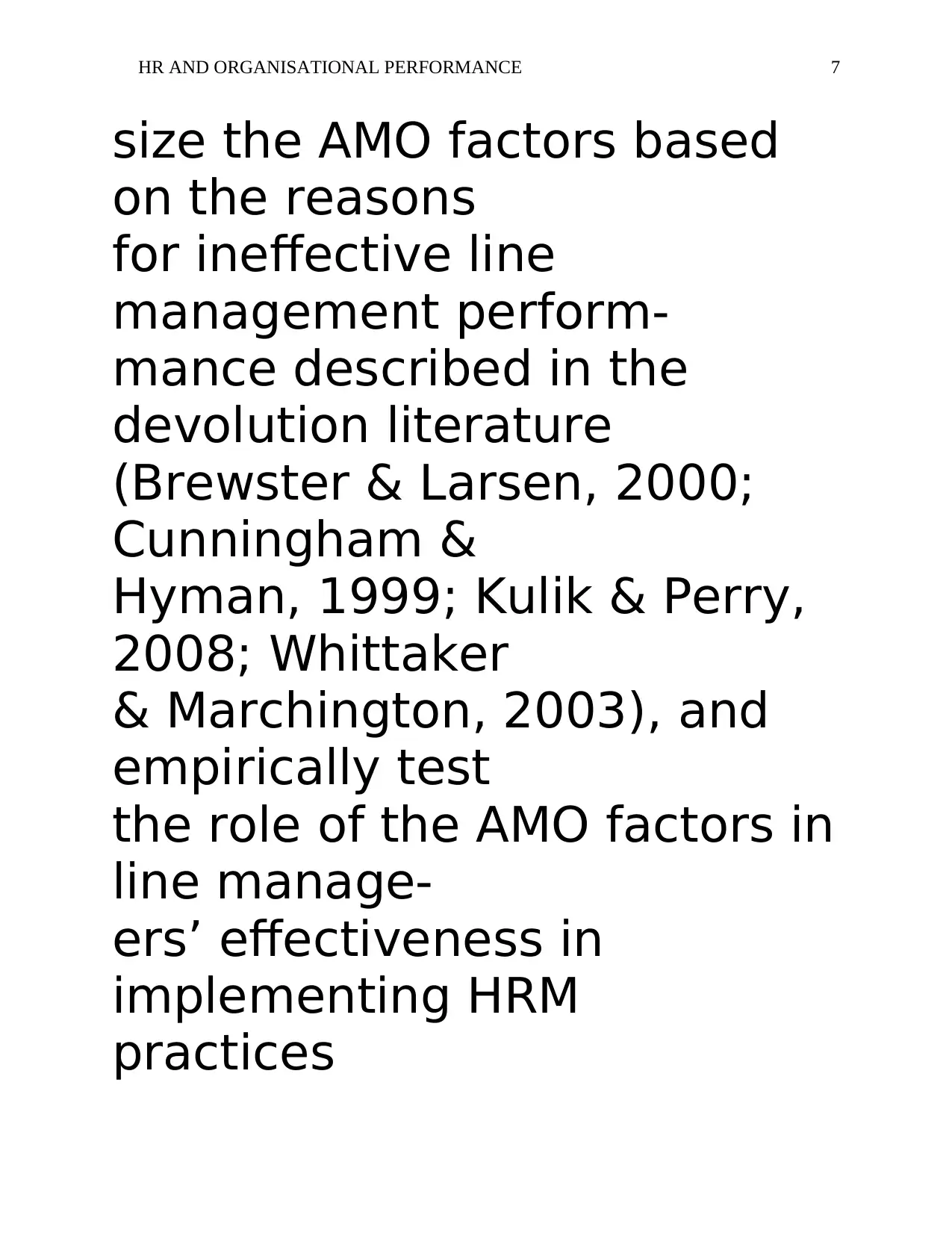
HR AND ORGANISATIONAL PERFORMANCE 7
size the AMO factors based
on the reasons
for ineffective line
management perform-
mance described in the
devolution literature
(Brewster & Larsen, 2000;
Cunningham &
Hyman, 1999; Kulik & Perry,
2008; Whittaker
& Marchington, 2003), and
empirically test
the role of the AMO factors in
line manage-
ers’ effectiveness in
implementing HRM
practices
size the AMO factors based
on the reasons
for ineffective line
management perform-
mance described in the
devolution literature
(Brewster & Larsen, 2000;
Cunningham &
Hyman, 1999; Kulik & Perry,
2008; Whittaker
& Marchington, 2003), and
empirically test
the role of the AMO factors in
line manage-
ers’ effectiveness in
implementing HRM
practices
Paraphrase This Document
Need a fresh take? Get an instant paraphrase of this document with our AI Paraphraser
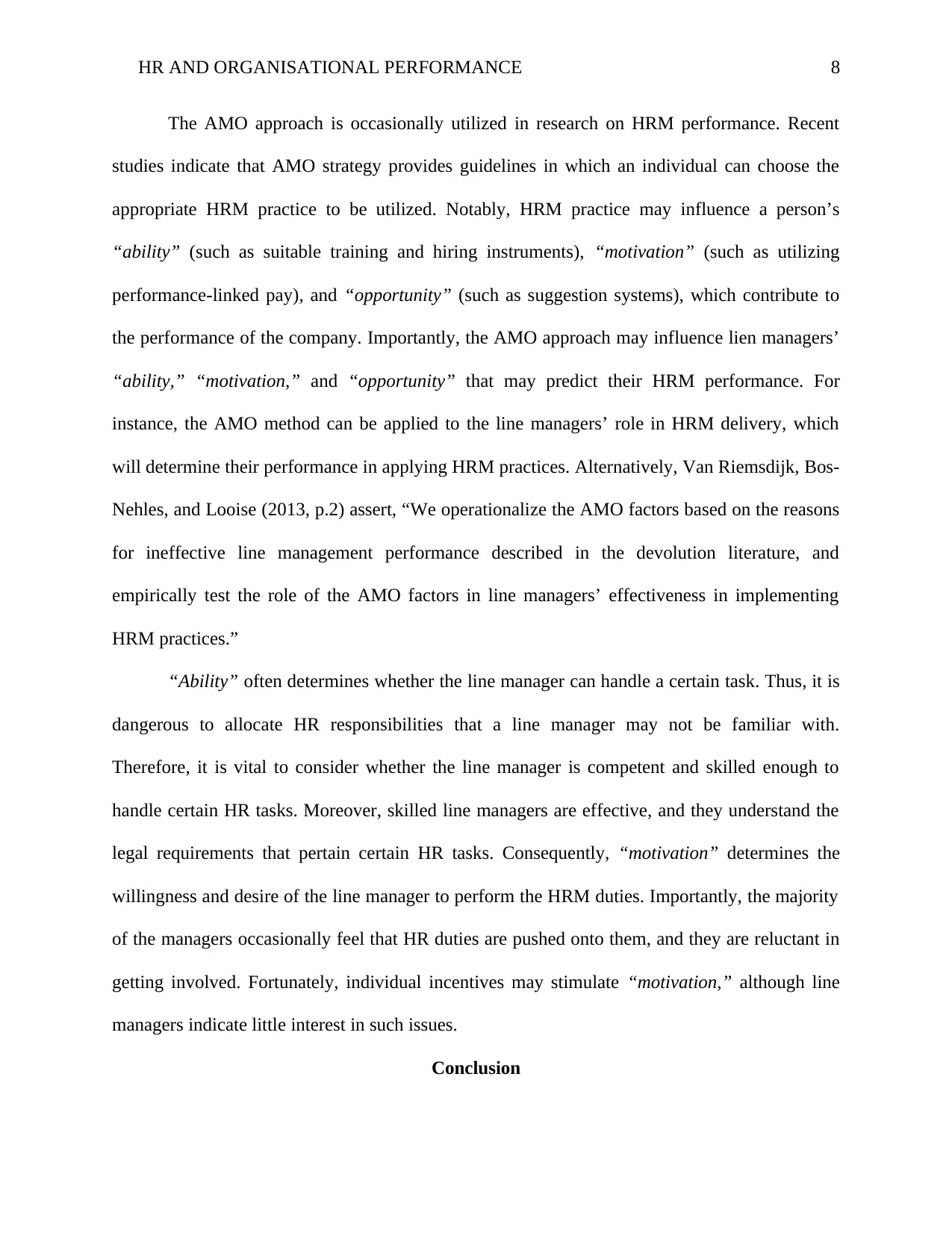
HR AND ORGANISATIONAL PERFORMANCE 8
The AMO approach is occasionally utilized in research on HRM performance. Recent
studies indicate that AMO strategy provides guidelines in which an individual can choose the
appropriate HRM practice to be utilized. Notably, HRM practice may influence a person’s
“ability” (such as suitable training and hiring instruments), “motivation” (such as utilizing
performance-linked pay), and “opportunity” (such as suggestion systems), which contribute to
the performance of the company. Importantly, the AMO approach may influence lien managers’
“ability,” “motivation,” and “opportunity” that may predict their HRM performance. For
instance, the AMO method can be applied to the line managers’ role in HRM delivery, which
will determine their performance in applying HRM practices. Alternatively, Van Riemsdijk, Bos-
Nehles, and Looise (2013, p.2) assert, “We operationalize the AMO factors based on the reasons
for ineffective line management performance described in the devolution literature, and
empirically test the role of the AMO factors in line managers’ effectiveness in implementing
HRM practices.”
“Ability” often determines whether the line manager can handle a certain task. Thus, it is
dangerous to allocate HR responsibilities that a line manager may not be familiar with.
Therefore, it is vital to consider whether the line manager is competent and skilled enough to
handle certain HR tasks. Moreover, skilled line managers are effective, and they understand the
legal requirements that pertain certain HR tasks. Consequently, “motivation” determines the
willingness and desire of the line manager to perform the HRM duties. Importantly, the majority
of the managers occasionally feel that HR duties are pushed onto them, and they are reluctant in
getting involved. Fortunately, individual incentives may stimulate “motivation,” although line
managers indicate little interest in such issues.
Conclusion
The AMO approach is occasionally utilized in research on HRM performance. Recent
studies indicate that AMO strategy provides guidelines in which an individual can choose the
appropriate HRM practice to be utilized. Notably, HRM practice may influence a person’s
“ability” (such as suitable training and hiring instruments), “motivation” (such as utilizing
performance-linked pay), and “opportunity” (such as suggestion systems), which contribute to
the performance of the company. Importantly, the AMO approach may influence lien managers’
“ability,” “motivation,” and “opportunity” that may predict their HRM performance. For
instance, the AMO method can be applied to the line managers’ role in HRM delivery, which
will determine their performance in applying HRM practices. Alternatively, Van Riemsdijk, Bos-
Nehles, and Looise (2013, p.2) assert, “We operationalize the AMO factors based on the reasons
for ineffective line management performance described in the devolution literature, and
empirically test the role of the AMO factors in line managers’ effectiveness in implementing
HRM practices.”
“Ability” often determines whether the line manager can handle a certain task. Thus, it is
dangerous to allocate HR responsibilities that a line manager may not be familiar with.
Therefore, it is vital to consider whether the line manager is competent and skilled enough to
handle certain HR tasks. Moreover, skilled line managers are effective, and they understand the
legal requirements that pertain certain HR tasks. Consequently, “motivation” determines the
willingness and desire of the line manager to perform the HRM duties. Importantly, the majority
of the managers occasionally feel that HR duties are pushed onto them, and they are reluctant in
getting involved. Fortunately, individual incentives may stimulate “motivation,” although line
managers indicate little interest in such issues.
Conclusion
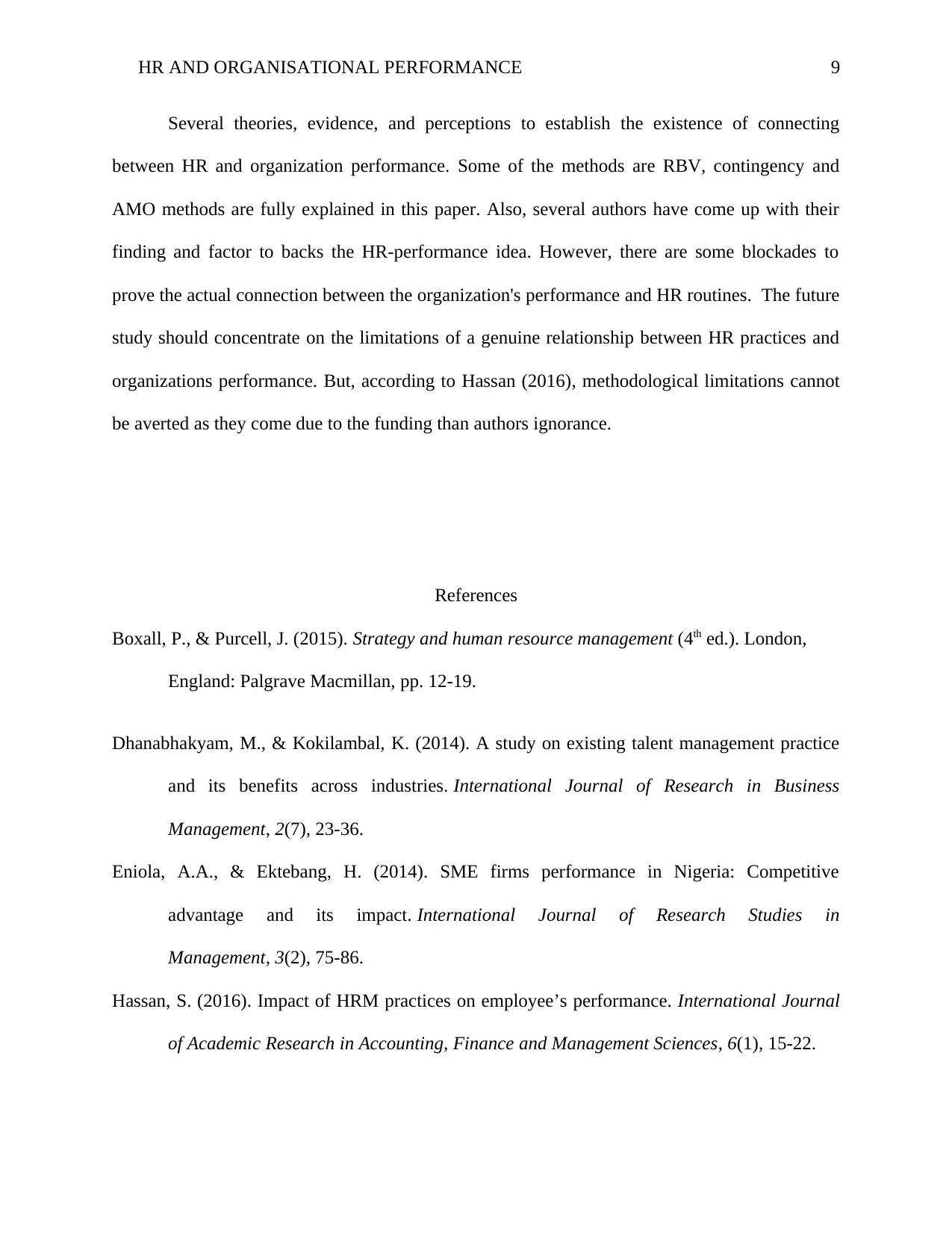
HR AND ORGANISATIONAL PERFORMANCE 9
Several theories, evidence, and perceptions to establish the existence of connecting
between HR and organization performance. Some of the methods are RBV, contingency and
AMO methods are fully explained in this paper. Also, several authors have come up with their
finding and factor to backs the HR-performance idea. However, there are some blockades to
prove the actual connection between the organization's performance and HR routines. The future
study should concentrate on the limitations of a genuine relationship between HR practices and
organizations performance. But, according to Hassan (2016), methodological limitations cannot
be averted as they come due to the funding than authors ignorance.
References
Boxall, P., & Purcell, J. (2015). Strategy and human resource management (4th ed.). London,
England: Palgrave Macmillan, pp. 12-19.
Dhanabhakyam, M., & Kokilambal, K. (2014). A study on existing talent management practice
and its benefits across industries. International Journal of Research in Business
Management, 2(7), 23-36.
Eniola, A.A., & Ektebang, H. (2014). SME firms performance in Nigeria: Competitive
advantage and its impact. International Journal of Research Studies in
Management, 3(2), 75-86.
Hassan, S. (2016). Impact of HRM practices on employee’s performance. International Journal
of Academic Research in Accounting, Finance and Management Sciences, 6(1), 15-22.
Several theories, evidence, and perceptions to establish the existence of connecting
between HR and organization performance. Some of the methods are RBV, contingency and
AMO methods are fully explained in this paper. Also, several authors have come up with their
finding and factor to backs the HR-performance idea. However, there are some blockades to
prove the actual connection between the organization's performance and HR routines. The future
study should concentrate on the limitations of a genuine relationship between HR practices and
organizations performance. But, according to Hassan (2016), methodological limitations cannot
be averted as they come due to the funding than authors ignorance.
References
Boxall, P., & Purcell, J. (2015). Strategy and human resource management (4th ed.). London,
England: Palgrave Macmillan, pp. 12-19.
Dhanabhakyam, M., & Kokilambal, K. (2014). A study on existing talent management practice
and its benefits across industries. International Journal of Research in Business
Management, 2(7), 23-36.
Eniola, A.A., & Ektebang, H. (2014). SME firms performance in Nigeria: Competitive
advantage and its impact. International Journal of Research Studies in
Management, 3(2), 75-86.
Hassan, S. (2016). Impact of HRM practices on employee’s performance. International Journal
of Academic Research in Accounting, Finance and Management Sciences, 6(1), 15-22.
⊘ This is a preview!⊘
Do you want full access?
Subscribe today to unlock all pages.

Trusted by 1+ million students worldwide
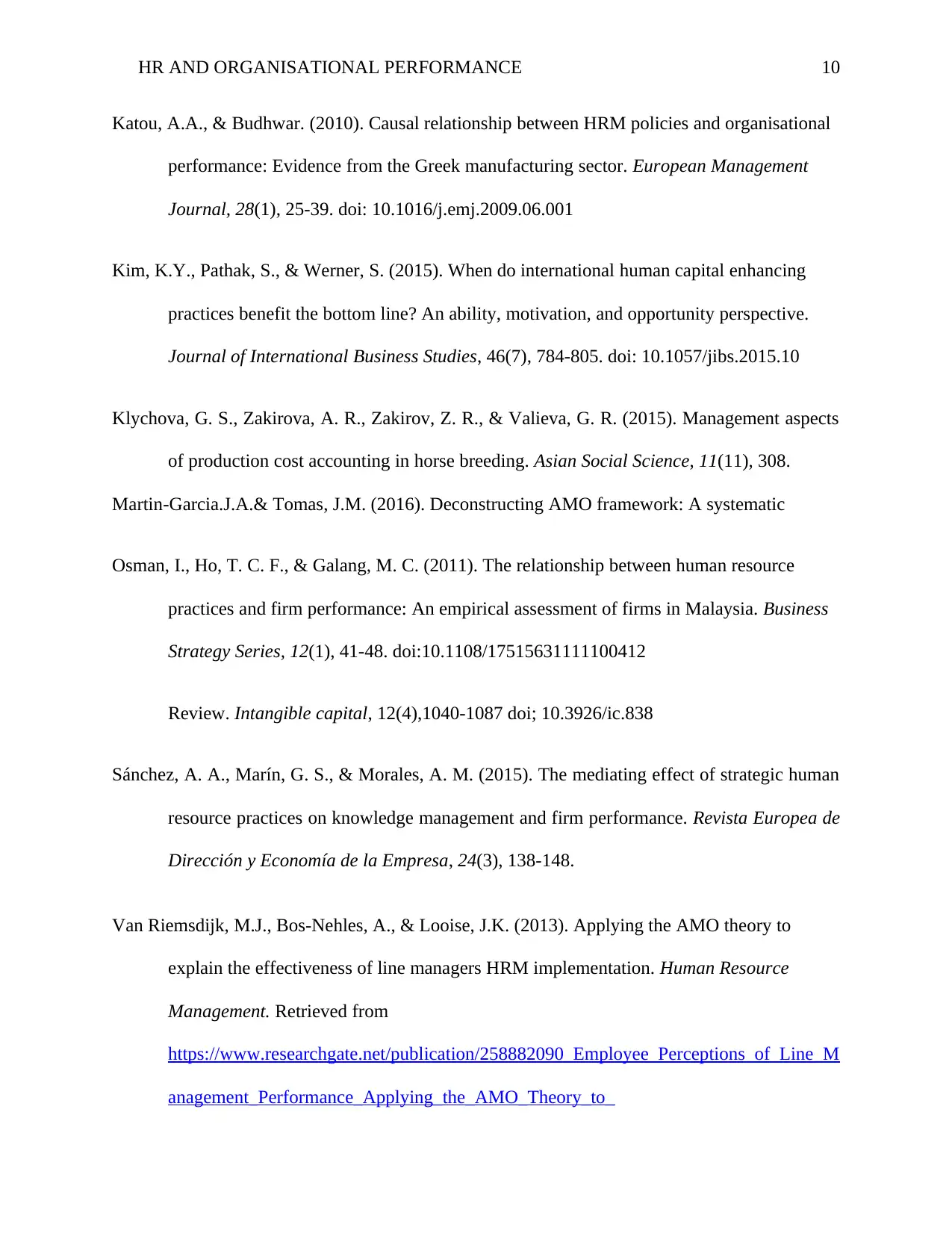
HR AND ORGANISATIONAL PERFORMANCE 10
Katou, A.A., & Budhwar. (2010). Causal relationship between HRM policies and organisational
performance: Evidence from the Greek manufacturing sector. European Management
Journal, 28(1), 25-39. doi: 10.1016/j.emj.2009.06.001
Kim, K.Y., Pathak, S., & Werner, S. (2015). When do international human capital enhancing
practices benefit the bottom line? An ability, motivation, and opportunity perspective.
Journal of International Business Studies, 46(7), 784-805. doi: 10.1057/jibs.2015.10
Klychova, G. S., Zakirova, A. R., Zakirov, Z. R., & Valieva, G. R. (2015). Management aspects
of production cost accounting in horse breeding. Asian Social Science, 11(11), 308.
Martin-Garcia.J.A.& Tomas, J.M. (2016). Deconstructing AMO framework: A systematic
Osman, I., Ho, T. C. F., & Galang, M. C. (2011). The relationship between human resource
practices and firm performance: An empirical assessment of firms in Malaysia. Business
Strategy Series, 12(1), 41-48. doi:10.1108/17515631111100412
Review. Intangible capital, 12(4),1040-1087 doi; 10.3926/ic.838
Sánchez, A. A., Marín, G. S., & Morales, A. M. (2015). The mediating effect of strategic human
resource practices on knowledge management and firm performance. Revista Europea de
Dirección y Economía de la Empresa, 24(3), 138-148.
Van Riemsdijk, M.J., Bos-Nehles, A., & Looise, J.K. (2013). Applying the AMO theory to
explain the effectiveness of line managers HRM implementation. Human Resource
Management. Retrieved from
https://www.researchgate.net/publication/258882090_Employee_Perceptions_of_Line_M
anagement_Performance_Applying_the_AMO_Theory_to_
Katou, A.A., & Budhwar. (2010). Causal relationship between HRM policies and organisational
performance: Evidence from the Greek manufacturing sector. European Management
Journal, 28(1), 25-39. doi: 10.1016/j.emj.2009.06.001
Kim, K.Y., Pathak, S., & Werner, S. (2015). When do international human capital enhancing
practices benefit the bottom line? An ability, motivation, and opportunity perspective.
Journal of International Business Studies, 46(7), 784-805. doi: 10.1057/jibs.2015.10
Klychova, G. S., Zakirova, A. R., Zakirov, Z. R., & Valieva, G. R. (2015). Management aspects
of production cost accounting in horse breeding. Asian Social Science, 11(11), 308.
Martin-Garcia.J.A.& Tomas, J.M. (2016). Deconstructing AMO framework: A systematic
Osman, I., Ho, T. C. F., & Galang, M. C. (2011). The relationship between human resource
practices and firm performance: An empirical assessment of firms in Malaysia. Business
Strategy Series, 12(1), 41-48. doi:10.1108/17515631111100412
Review. Intangible capital, 12(4),1040-1087 doi; 10.3926/ic.838
Sánchez, A. A., Marín, G. S., & Morales, A. M. (2015). The mediating effect of strategic human
resource practices on knowledge management and firm performance. Revista Europea de
Dirección y Economía de la Empresa, 24(3), 138-148.
Van Riemsdijk, M.J., Bos-Nehles, A., & Looise, J.K. (2013). Applying the AMO theory to
explain the effectiveness of line managers HRM implementation. Human Resource
Management. Retrieved from
https://www.researchgate.net/publication/258882090_Employee_Perceptions_of_Line_M
anagement_Performance_Applying_the_AMO_Theory_to_
Paraphrase This Document
Need a fresh take? Get an instant paraphrase of this document with our AI Paraphraser
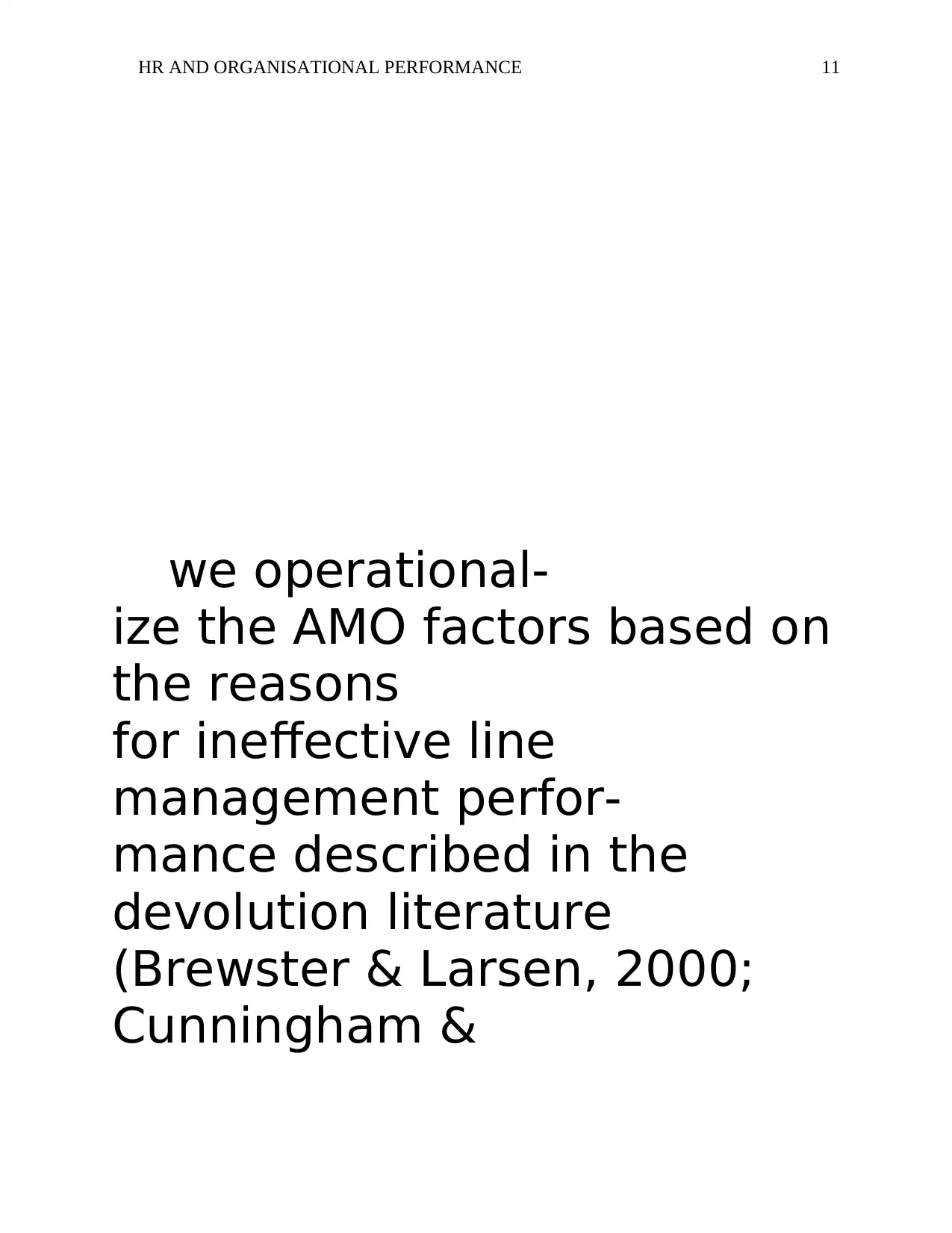
HR AND ORGANISATIONAL PERFORMANCE 11
we operational-
ize the AMO factors based on
the reasons
for ineffective line
management perfor-
mance described in the
devolution literature
(Brewster & Larsen, 2000;
Cunningham &
we operational-
ize the AMO factors based on
the reasons
for ineffective line
management perfor-
mance described in the
devolution literature
(Brewster & Larsen, 2000;
Cunningham &
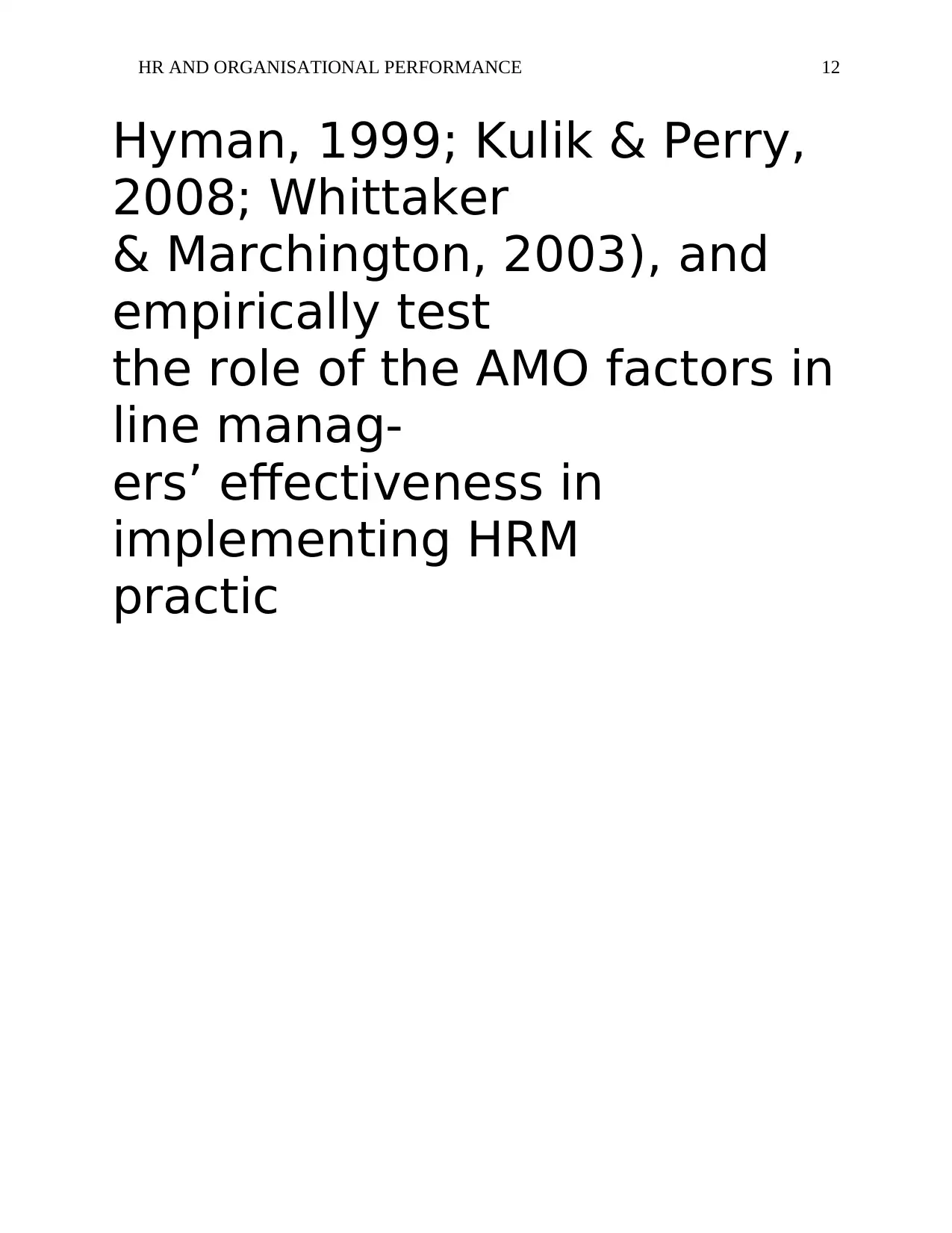
HR AND ORGANISATIONAL PERFORMANCE 12
Hyman, 1999; Kulik & Perry,
2008; Whittaker
& Marchington, 2003), and
empirically test
the role of the AMO factors in
line manag-
ers’ effectiveness in
implementing HRM
practic
Hyman, 1999; Kulik & Perry,
2008; Whittaker
& Marchington, 2003), and
empirically test
the role of the AMO factors in
line manag-
ers’ effectiveness in
implementing HRM
practic
⊘ This is a preview!⊘
Do you want full access?
Subscribe today to unlock all pages.

Trusted by 1+ million students worldwide
1 out of 12
Related Documents
Your All-in-One AI-Powered Toolkit for Academic Success.
+13062052269
info@desklib.com
Available 24*7 on WhatsApp / Email
![[object Object]](/_next/static/media/star-bottom.7253800d.svg)
Unlock your academic potential
Copyright © 2020–2025 A2Z Services. All Rights Reserved. Developed and managed by ZUCOL.



